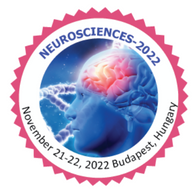Sessions/Tracks
Track 01: Neurology
The discipline of medicine known as neurology deals with problems of the nervous system, which includes the brain, blood vessels, muscles, and nerves. The involuntary, central, and peripheral nervous systems make up the majority of neurology.
-
Central nervous system
-
Nervous system of the periphery
-
Neurology in general
-
Cerebrovascular disease
Track 02: Autonomic Neurology
Autonomic Neurology is a branch of neurology that deals with the study of the body's and nervous systems autonomic functions. Treatment of neurons that affect heartbeat, vein broadening or narrowing, swallowing, and so on is included in involuntary neurology. Different types of illnesses emerge from the dynamic deterioration of the involuntary nervous system nerve cell.
-
Standing up causes dizziness and fainting, or hypotension.
-
Exercise intolerance is the inability to modify one's pulse rate when exercising.
-
Sweating irregularities in which you oscillate between sweating excessively and sweating insufficiently.
Track 03: Behavioural Neurology
Behavioural Neurology is a subspecialty of Neurology that deals with the investigation, treatment, and supervision of patients who have changed behavior as a result of a mental illness. A small percentage of the messes are caused by mental illness or injuries. This problem will change your ability to recognize things and think.
Track 04: Neurological Disorders
The progressive loss of structure and functioning of Neurons is the primary cause of Neurological Disorders. Neurons can potentially die as a result of it. Medicine Diseases such as Parkinson's, ALS, Huntington's, and others may be caused by disorders. Several items of analysis are occurring, yet these disorders are incurable. Nerve cells degenerate or die as a result of this condition. This degradation results in psychological symptom behavior and a variety of treatment choices.
-
Poor or ineffective judgment
-
Irritable, apprehensive, suspicious, and inappropriate personalities emerge.
-
Sudden weakness, symptom, or vision loss are all possible causes.
-
Tremors, tremors, tremors, tremors
-
Walking becomes difficult as a result of shuffled steps or impaired balance.
-
Convulsions, loss of consciousness, etc.
Track 05: Clinical Neurophysiology or Physiology
Neurophysiology is an area of science in which bioelectric activity in the brain is studied, whether it is spontaneous or provoked. It discusses the pathophysiology of illnesses of the CNS and PNS, as well as clinical procedures for diagnosing them. The branch aids in determining the precise severity of brain damage.
-
Electromyography
-
Potentials that have been evoked
-
Monitoring during surgery
Track 06: Cognitive Neurology
The study of neurobiology, psychology, and the area of psychological medicine is known as cognitive neurology. In terms of psychological features, all fields of Neurology overlap. Its research focuses on the neurological underpinnings of mental processes and how they exhibit themselves in action.
Track 07: Geriatric Neurology
It is a subspecialty of neurology that deals with the diagnosis, treatment, and management of neurological disorders that arise as a result of the ageing process. It also includes specialization monitoring of the ageing central nervous system and its vulnerable effects as a result of a variety of medical specialty diseases. Insanity, Alzheimer's, Parkinson's disease, and gait abnormalities are all included in this Neurology study, as well as the effects of drugs on the neurological system.
Track 08: Neuropharmacology
The study of how medications affect cellular activity, the nervous system, and the neural system through which they influence behavior is known as neuropharmacology. Behavioral and molecular neuropharmacology is the two disciplines of neuropharmacology. Behavioural science is primarily concerned with the study of how drugs affect human behavior, especially the effects of drug dependence and addiction on the human brain. The study of neurons and their neurochemical communication is referred to as molecular neuropharmacology, and it aims to discover medications that improve neurological function.
-
Anti-anxiety medications
-
Drugs that are currently in development
-
Neuroimmuno pharmacology
-
Interaction of chemicals in the brain
-
Genome wide association studies
-
Biochemical genetics
Track 09: Neurogenetics
Neurogenetics is that the branch of science which mixes Genetics and Neurology. It's the study of the event and performance of the Nervous system furthermore because the role competes by genes in its development. A large range of disorders and diseases may be determined by Neurogenetics. It studies the role of genetics in the development and function of the nervous system. It considers neural characteristics as phenotypes and is mainly based on the observation that the nervous systems of individuals, even of those belonging to the same species, may not be identical.
Track 10: Neural Engineering
Various medical specialist engineering or bio-engineering techniques are employed in neural engineering to study, repair, replace, augment, or otherwise exploit the features of the neural system. Neural engineers can tackle problems at the interface of living tissue and non-living structures. To investigate and learn about brain activity, they employ various electromagnetic techniques such as MRI scanning.
Track 11: Neuroimaging
It's also known as brain imaging, and it's a term that refers to a variety of approaches for imaging the anatomy and function of the neurological system, either directly or indirectly. It's a relatively young field of study in the field of neurobiology. Neuroradiologists are physicians who specialize in neuroimaging. There are two types of neuroimaging: structural imaging and intentional imaging.
-
Imaging of the Anatomy
-
Fusion Imaging is a term used to describe a type of imaging that
-
Neuroimaging, both functional and structural
-
Kurtosis imaging and a diffusion male person
-
Computational axial imaging using single-photon emission
Track 12: Neuro Immunology
It is a subject that combines neurobiology and immunology, or the study of the nervous system and, by extension, the immune system. Neuroimmunologists have a better understanding of the interplay between these two complex systems. The purpose of neuro immunology research is to better understand the pathogenesis of certain neurologic illnesses that have no identifiable cause. Neuro immunology has had a role in the development of new pharmaceutical treatments for a variety of neurologic diseases.Neuropathies caused by autoimmunity
-
Neuroimmunogenetics is the study of how the brain and immune system interact.
-
Neurovirology is a branch of medicine that deals with viruses.
-
Inflammation of the nervous system
Track 13: Neurosurgery and Spine
-
Vascular neurosurgery
-
Pediatrics neurosurgery
-
Neurological & Psychiatric Disorders
-
Brain Injury & Brain Tumor
-
Functional neurosurgery
-
Spine Neurosurgery
-
Skull base Neurosurgery
Track 14: Neuropsychiatry
Neuropsychiatry is the branch of medicine that deals with mental illnesses that are caused by problems with the neurological system. Neurology and psychiatry are both included. It's linked to the fields of neuropsychology and behavioral neurology.
Track 15: Neuro-Oncology
The study of tumours of the brain and medulla spinal is known as neuro-oncology. Nervous system cancers are frequently serious and life-threatening. Chemotherapy and radiation therapy have been used to extend survival in some circumstances. The branch of medicine known as neuro oncology deals with tumours of the brain, spinal cord, and peripheral nerves. Neuro-Oncology oversees a number of clinical studies with a focus on primary brain malignancies such as glioblastoma, medulloblastoma, anaplastic astrocytoma, low-grade astrocytoma, and glioma recurrences. Neuro-oncologists are specialists who treat and manage primary, metastatic central and peripheral nervous system neoplasms, as well as cancer-related neurologic squeal and other illnesses.
-
Neuro-oncology surgery
-
Neurosurgical Oncology
-
Tumor Biomarkers
-
Rehabilitation for Brain Injuries
-
Pathophysiology in Neuro Oncology
-
Types of pain in Neuro Oncology
-
Neuro-oncology in children and adolescents
Track 16: Parkinson’s Diseases
Parkinson's disease is marked by the death of brain cells, or funiculi, which leads to dysfunction and incapacity over time. It primarily affects dopamine-producing neurons in an extremely specialized area where cells produce dopamine. Parkinson's disease manifests itself in a progressive manner. They usually start with a tiny tremor in one hand and a feeling of rigidity throughout the body.
Symptoms:
-
Tremors (shaking) are a type of tre
-
Slowing down of movement
-
Muscles that are rigid
-
The way people speak changes.
-
Changes in the writing
Track 17: Computational Neurology
The study of the brain and its functioning using information science structures that mimic the nervous system is known as computational neurology. It entails the use of laptop simulations and, as a result, theoretical models to examine the brain's and system's functions.
-
Tumors
-
Cauda equina syndrome
-
Spina bifida
-
Lumbar spinal stenosis
-
Scoliosis
Track 18: Alzheimer’s diseases
Alzheimer's disease is a neurological condition. Alzheimer's disease is the most well-known form of insanity, a collection of symptoms that impair mental function. Alzheimer's disease is a dynamic and irreversible disease. Cognitive state is one of the most common early warning signs, along with a progressive decline in various intellectual and cognitive capacities, often known as intellectual capacities, and changes in identity or behavior.
-
Treatment of Alzheimer’s disease
-
-
Stroke related dementia
-
-
Computational and mathematical modeling of dementia
-
-
White matter and dementia
-
-
Sleep and dementia
-
-
Young onset dementia
Track 19: Radiology
The branch of radiology that specializes in the diagnosis and treatment of nervous system illnesses using radioactive chemicals, x-rays, and scanning instruments. Clinical imaging, therapy, and basic science of the central and peripheral nervous systems, including but not limited to the brain, spine, head and neck, interventional procedures, imaging and intervention techniques, and related educational, socioeconomic, and medico legal issues, are all covered by neuroradiology.
Track 20: Neuropsychology and Neurorehabilitation
Neuropsychology is a field that encompasses both neurology and psychology. It is the study and description of the behavioral changes that occur as a result of a neurological injury or disorder. Neurorehabilitation is a complicated medical procedure that aids in the recovery of nervous system injuries or the reduction of functional impairments.
-
Cortical remapping
-
Clearly necessitating restraint
-
Intensive stimulation of brain networks that have been damaged
Track 21: Metastasis
Metastasis is a pathogenic specialist's spread from an underlying or essential site to an alternate or auxiliary site inside the host's body. The term is commonly utilized when alluding to metastasis by a Cancerous tumor. The spread of cancer cells from where they initially framed to another piece of the body. In metastasis, cancer cells split away from the first (essential) tumor, travel through the blood or lymph system, and structure another tumor in different organs or tissues of the body. The new, metastatic tumor is a similar sort of cancer growth as the essential tumor. Cancer happens after cells are hereditarily modified to multiply quickly and uncertainly. This uncontrolled multiplication by mitosis delivers an essential heterogeneic tumor. The cells which establish the tumor in the end go through metaplasia, trailed by dysplasia then anaplasia, bringing about a malignant phenotype. This malignancy allows for invasion into the dissemination, followed by intrusion to a second site for tumorigenesis.
-
Transcoelomic.
-
Lymphatic spread.
-
Hematogenous spread.
Track 22: Pediatric Neurology
Pediatric neurology, often known as child neurology, is a specialty of medicine that focuses on the diagnosis and treatment of neurological disorders in newborns, babies, children, and adolescents. Child neurology is the study of diseases and disorders of the spinal cord, brain, peripheral nervous system, autonomic nervous system, muscles, and blood vessels in children and adolescents. A pediatric neurologist has the specialized skills and understanding to assess, diagnose, and treat a kid who has abnormalities with the neurological system. Pediatric neurologists treat a wide range of illnesses, from relatively simple problems like migraine or cerebral palsy to more difficult and unusual conditions like metabolic disease or neurodegenerative disorders.
Track 23: Neuro-ophthalmology
Neuro-ophthalmology is a specialization of both neurology and ophthalmology that specializes in the treatment of visual abnormalities that are caused by the neurological system, rather than the eyes themselves. Vision-related functions occupy over half of the brain. Neuro-ophthalmologists are doctors who specialize in disorders involving the eyes, brain, nerves, and muscles. Following medical school, these doctors complete at least five years of clinical training and are usually board-certified in neurology, ophthalmology, or both. Neuro-ophthalmologists have the unique ability to assess patients from neurologic, ophthalmologic, and medical perspectives in order to diagnose and treat a wide range of issues.
Track 24: Stem Cells and Neuroregeneration
The nervous system is a sophisticated network of nerves that organizes its actions by sending and receiving signals from various parts of the body. The regrowth or repair of neural tissues, cells, or cell materials is referred to as neuroregeneration. Stem cell therapy, in particular, is a tailored, localized, and likely fruitful alternative in patient care that is still being researched. Cerebrovascular disorders, Alzheimer's disease (AD), and Parkinson's disease (PD) all entail the injury, degeneration, and death of neural cells in the central nervous system.
Track 25: Cellular-Neuroscience
Cellular neuroscience is a subfield of neuroscience that studies neurons at the cellular level. Cellular neuroscience investigates the numerous types of neurons, their activities, how neurons interact with one another, and how neurons work together. This paper looks at how far we've come in understanding central nervous system development and function using morphological, genetic, molecular, and advanced physiological techniques. Neuron physiology and molecular biology are investigated. We'll focus on cellular, genetic, and molecular mechanisms in particular. Although the majority, if not all, of the mechanisms that give rise to the nervous system are conserved across all animals, they were frequently found using model organisms.
Track 26: Neuroplasticity
The ability of neuronal networks in the brain to change through development and reorganization is known as neuroplasticity, sometimes known as neural plasticity or brain plasticity. Individual neuron pathways forming new connections to systematic alterations like cortical remapping are examples of these changes. Circuit and network modifications as a result of learning a new skill, environmental factors, practice, and psychological stress are examples of neuroplasticity. Structural neuroplasticity and functional neuroplasticity are two types of neuroplasticity.
Track 27: Brain Tumour and Brain Injury
A malignant or non-cancerous mass in the brain, or aberrant cell proliferation. Tumours in the brain can originate, or cancer from another part of the body can travel to the brain. New or worsening headaches, impaired vision, loss of balance, confusion, and seizures are some of the symptoms. There may be no symptoms in some cases. Surgery, radiation, and chemotherapy are all options for treatment.
An external force, generally a forceful knock to the head, causes brain damage. A serious sports injury or a vehicle accident is common causes of traumatic brain damage. Confusion, fuzzy vision, and difficulty concentrating are some of the immediate or delayed symptoms. Infants may cry a lot or become irritated. Rest, medicine, and surgery may all be used to treat the condition.
Track 28: Neurovascular Disorder
The common mode of expression of stroke could be a relatively sudden occurrence of a focal neurological deficit. Strokes are broadly categorized as ischemic or hemorrhagic. Ischemic stroke is due to the occlusion of a cerebral blood vessel and causes cerebral infarction. Knowledge of the stroke syndromes, the signs, and symptoms that correspond to the region of the brain that's supplied by each vessel, allows a degree of precision in determining the particular vessel that's occluded, and from the temporal evolution of the syndrome, the underlying explanation for vascular occlusion is often deduced. Cerebrovascular disease refers to a group of conditions, diseases, and disorders that affect the blood vessels and blood supply to the brain. Neurovascular disease can develop from a spread of causes, including atherosclerosis, where the arteries become narrow; thrombosis, or embolic blood clot, which may be a grume in an artery of the brain or cerebral phlebothrombosis which may be a blood clot during a vein of the brain.
-
Vascular Malformations
-
Carotid Artery Disease
-
Venous Sinus Thrombosis
-
Intracranial Vascular Disease
-
Carotid-cavernous Fistula
Track 29: Brain Mapping
Imaging, immunohistochemistry, molecular and optogenetics, stem cell and cell biology, engineering, neurophysiology, and nanotechnology are all used in brain mapping to examine the structure and features of the mind and spinal cord. The improvement and refinement of photo capture, representation, analysis, visualization, and interpretation procedures are all important components of brain mapping strategies. Functional and structural neuroimaging are at the heart of mind mapping's mapping component.
Track 30: Spine Surgery
A bone transplant is used in spinal fusion surgery to stop the motion at a problematic vertebral section, which should reduce pain caused by the joint. Along with spinal fusion, medical equipment for spine surgery, bone graft measures, and a bone stimulator are sometimes used. The majority of lower back discomfort can be addressed without surgery. In reality, studies show that 20 to 40% of back procedures fail. This lack of success is so widespread that it has its own medical term: failure syndrome. Back surgery failure syndrome











